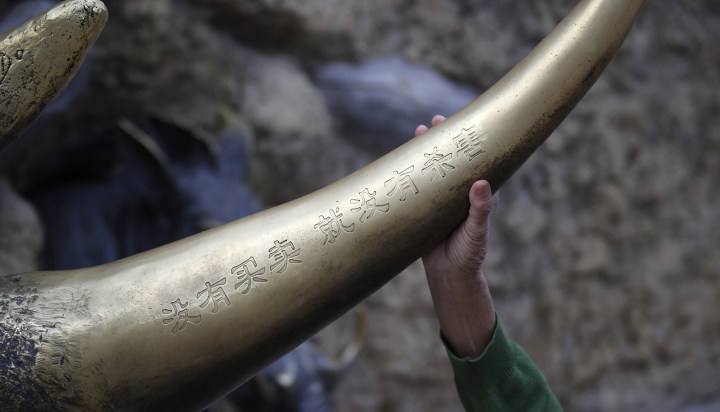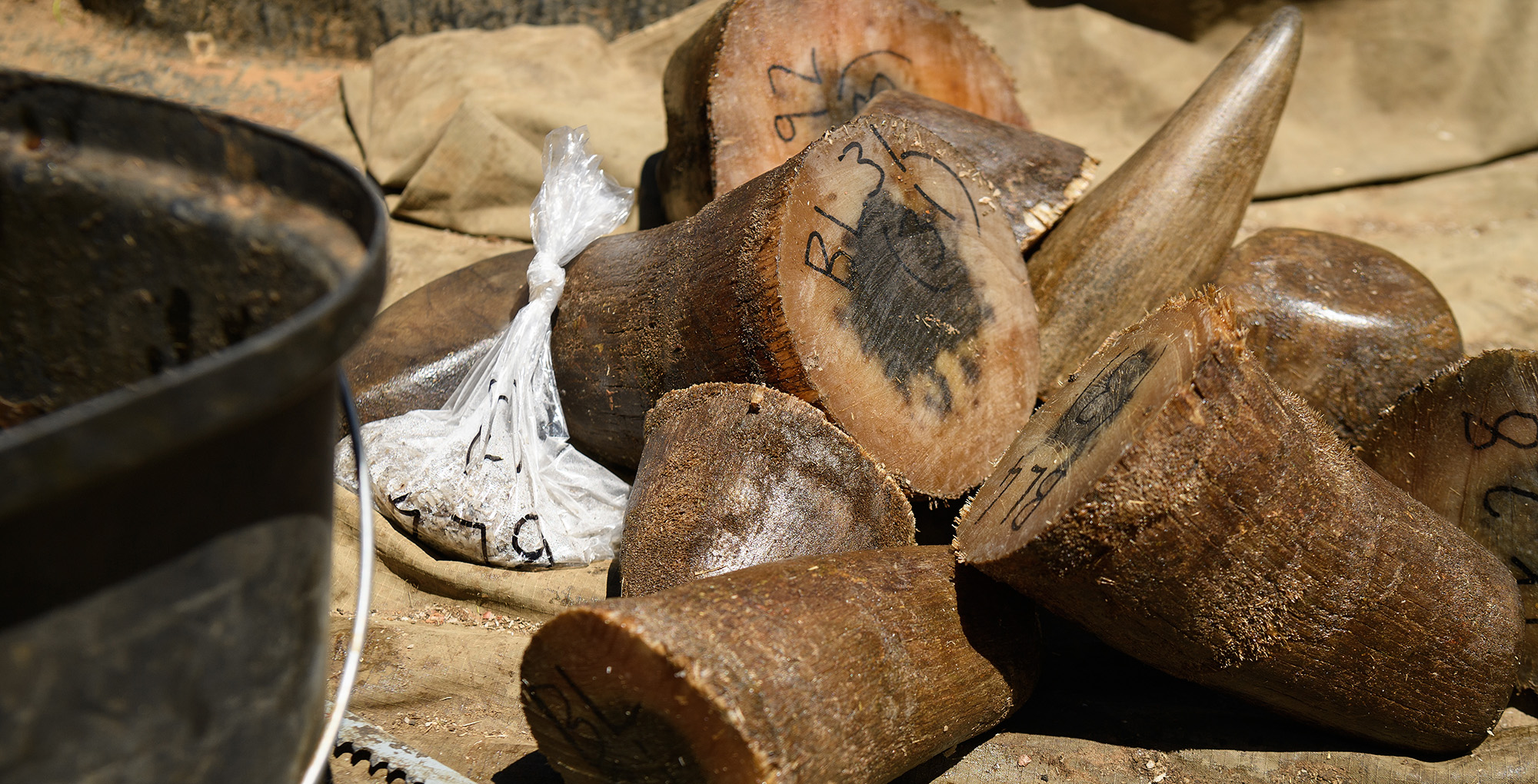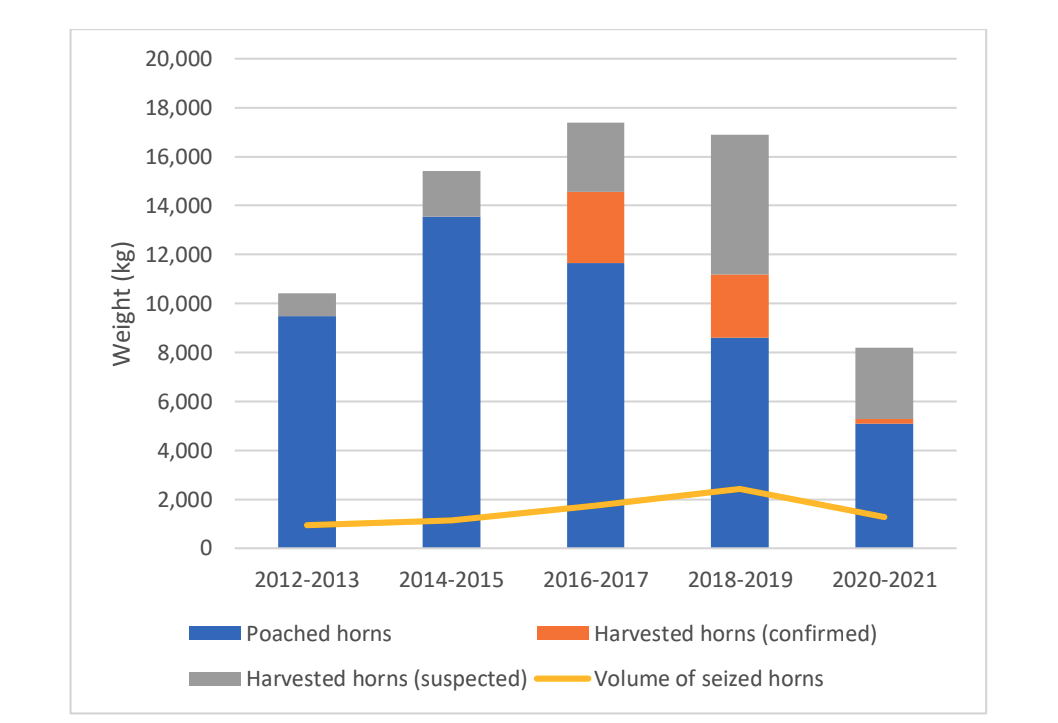WILDLIFE CRIMINAL ENTERPRISES
Rhino horn illicit trade driven by demand for luxury carvings, not medicine – new report

A new report by the Wildlife Justice Commission shines fresh light on the illicit trade in rhino horn that has decimated wild populations. It highlights an apparent rise in harvested horn from legal stockpiles making its way into the illicit trade. And in defiance of conventional wisdom, it maintains the main driver is Chinese demand for carvings, not Vietnamese yearnings for a hangover cure.
The report, released on Thursday, adds new and, in some ways, iconoclastic elements to the narrative around the illegal trade in rhino horn, which remains a lucrative criminal enterprise to the peril of the pachyderms.
Compiled by the Wildlife Justice Commission, an NGO focused on protecting vulnerable wildlife from exploitation by transnational organised crime networks, it examines 674 rhino horn seizures from 1 January 2012 until the end of 2021. It also draws on criminal intelligence and the NGO’s own investigations since 2015.
Comprehensive and up to date, the report comes against the backdrop of mounting concerns about the species’ decline in South Africa as poachers, having decimated the populations in the Kruger National Park, target new reserves. It also comes weeks before the next “Conference of the Parties” of the UN Convention on International Trade in Endangered Species (CITES), to be held in Panama, in which thorny issues around consumption and trade in wildlife products will take centre stage.
Key findings of “Rhino horn trafficking as a form of transnational organised crime (2012-2021): 2022 Global Threat Assessment” include:
- Significant numbers of harvested horns from legal stockpiles are diverted into illegal trade;
- China is the key market where rhino horn is mostly coveted for its rarity and bling as a luxury carved product. This far outstrips medicinal demand which is sourced from off-cuts and leftover pieces from the carving process – sort of like what goes into sausage;
- Wholesale rhino horn value is consistently less than one-third of the commonly reported value of $65,000 per kilogram. (Eds: It must be noted on this front that while that number is thrown around a lot, it often refers to the retail price on the street and not the wholesale price, as the report asserts); and
- Malaysia is playing an increasingly important role as a transit point for shipments from Africa to Asia.

Officials remove smuggled rhino horn pieces from plaster at Nội Bài International Airport in Hanoi, Vietnam, 25 July 2019. (Photo: EPA-EFE / STR)
Lure of stockpiles
Legal stockpiles, both government and private, are clearly a tempting target. They are the product of seizures as well as dehorning operations which are carried out as a deterrent to poaching on both private and state reserves.
“Since 2016, at least 974kg of rhino horns seized in 11 incidents were confirmed as originating from the theft or illegal sale of horns from legal stocks, including both privately owned and government-owned stockpiles. These incidents represent 18% of all rhino horns seized during the period from 2016-2021,” the report says.
“Further analysis of the seizure data indicated an additional 1,546kg of rhino horns across the entire 10-year period could also potentially represent diversion from legal stockpiles, which together with the confirmed instances would amount to 2,520kg, or up to one-third of all rhino horns seized globally.”
One obvious reason behind the raiding of stockpiles is the sharp decline in rhino populations in the face of the poaching onslaught. The Kruger National Park was for years the epicentre of the poaching crisis but its population has plunged, perhaps by 70% or more, over the past decade. Poachers have shifted their focus to KwaZulu-Natal and to private reserves, which may now account for 60% of a shrinking national herd that numbers fewer than 13,000.
Read more in Daily Maverick:
“Rhino poaching on the rise, KZN focus of carnage while private sector turns the tide”
“Shocking statistics reveal that Kruger rhino population has dropped by nearly 70% in 10 years”
“Criminal groups are routinely exploiting weaknesses in stockpile systems to access harvested rhino horns for the illegal trade,” the report says.
It also points as a possible factor to the lifting of the ban on domestic trade in South Africa in 2017, which has been a muddled process.

Trimmed rhino horns are seen in the back of a pick-up truck after being weighed, measured and marked, at the ranch of rhino breeder John Hume, 16 October 2017, in the North West of South Africa. (Photo: Leon Neal / Getty Images)

A rhino horn after being extracted at John Humeís farm on 8 September 2016 in Klerksdorp, South Africa. (Photo: Gallo Images / Rapport / Conrad Bornman)
Visit Daily Maverick’s home page for more news, analysis and investigations
The true driver
The findings on Chinese demand for carvings are at odds with the narrative that a key demand driver has been Vietnamese consumers yearning for hangover or cancer cures. Medicinal demand exists, but carving as a consumer preference mirrors the ivory trade. It also means the horn is not consumed, so, like ivory, there must be physical evidence of it adorning affluent Chinese homes.
Its assessment of pricing is also interesting – $65,000 per kilogram has for the past decade been thrown around as the going wholesale or retail price.
“At source locations in South Africa and Mozambique it can be one-tenth of this amount. Despite actual values being substantially lower than the commonly quoted amount, rhino horn is nonetheless still regarded in criminal circles as being very profitable,” it says. “The smaller size of back horns limits the type and quantity of products they can be processed into, rendering them less preferable and therefore cheaper per kilogram than the front horn in illegal trade.”
Malaysia’s emerging role in the trade is also a concern since it points to new routes being taken.
Corruption, of course, is a key enabler, which is no surprise as South Africa is the main supply source.
“One-third of rhino horns are smuggled unconcealed, suggesting a potential reliance on corruption to move shipments along the supply chain,” it says.

Estimated supply of African rhino horns entering illegal trade 2012-2021 based on reported rhino poaching in Africa and estimated diversion from legal stockpiles, compared with the volume of horns detected and seized globally by law enforcement authorities.
Gangster problem
Much of the reaction to the report will no doubt be predictable.
Conservationists who have been calling for maintaining the horn ban and burning stockpiles of rhino horn and elephant ivory will light a match under the issue. Those who support trade will point out that if stockpiles are being targeted, perhaps it’s time to transparently auction this supply so states can raise funds and private owners can realise a return on an investment that has contributed to the conservation of an iconic species.
For its part, the report largely steers clear of pro-trade or anti-trade policy recommendations, but on transnational crime it makes a number of sensible proposals: “Countries need to act on their international commitments to treat wildlife crime as a form of transnational organised crime… All countries and territories along the trafficking routes need to take coordinated action to address the insidious corruption that undermines law enforcement efforts.”
In short, it’s a gangster problem and needs to be treated as such.
“In any country with rhino horn stockpiles, domestic violations involving stockpiled horns should not be treated separately from international rhino horn-smuggling offences. Given the links between the movement of horn from illegally killed rhinos and harvested horns, these two supply chains should be addressed and managed as a connected threat,” it says.
It calls for law enforcement to be proactive and anticipate potential emerging threats posed by the dark web and cryptocurrency transactions. The report also recommends more research into the Chinese market and carving process.
One thing is clear: Asian demand, which is still not properly understood, is not going away anytime soon, and there is still a supply of rhino horn in stockpiles and attached to living animals that remains a profitable target to feed that demand. DM/OBP/BM


















 Become an Insider
Become an Insider
Only one sustainable route and that is to legalise the trade.
This will turn Rhino into an asset for landowners/custodians rather than a liability.
The free market will ensure that Rhino numbers, both in the wild and captivity, will flourish.
Sad commentary but practical